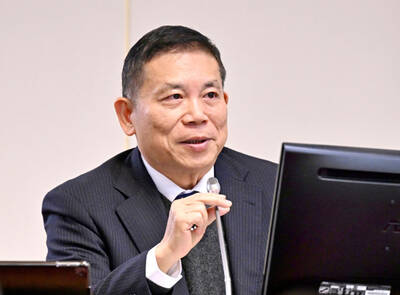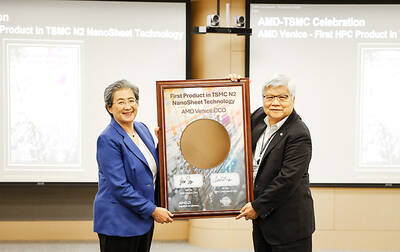China’s top flash memory chipmaker sees no easy way to replace US chipmaking gear, underscoring how a further crackdown on the supply of US technology would devastate the local semiconductor industry.
Yangtze Memory Technologies Co (長江存儲) gets more than 80 percent of its equipment from the US and Japan, said Zheng Jiuli (鄭久利), vice president in charge of supply chain management.
While some Chinese suppliers have made breakthroughs in areas, including etching and coating, there are not enough local alternatives to replace everything, he added.
“Long-term investments in innovation and R&D [research and development] have led to technological advantages” at US and Japanese suppliers, Zheng said.
“This is also the reason why their products are currently in the mainstream and are difficult to replace,” Zheng added.
The deficit of basic chipmaking equipment complicates Beijing’s ambitions to reduce its reliance on its geopolitical rival.
China has rolled out a number of measures to boost its domestic chip industry, including creating a US$29 billion semiconductor investment fund, and Beijing is planning to provide broad support for so-called third-generation semiconductors in its next five-year plan, Bloomberg News reported last week.
The manufacturing of these chipsets, which are mainly made of materials such as silicon carbide and gallium nitride, only has limited exposure to US vendors, Citigroup analysts have said.
Yangtze Memory has not set a target for domestic procurement, Zheng said, adding that it would be “unscientific” to do so.
The company operates a US$22 billion facility in Wuhan that is by far China’s most advanced factory for 3D NAND, the latest iteration of storage used in smartphones and high-end computing.

Taiwan will prioritize the development of silicon photonics by taking advantage of its strength in the semiconductor industry to build another shield to protect the local economy, National Development Council (NDC) Minister Paul Liu (劉鏡清) said yesterday. Speaking at a meeting of the legislature’s Economics Committee, Liu said Taiwan already has the artificial intelligence (AI) industry as a shield, after the semiconductor industry, to safeguard the country, and is looking at new unique fields to build more economic shields. While Taiwan will further strengthen its existing shields, over the longer term, the country is determined to focus on such potential segments as

UNCERTAINTY: Innolux activated a stringent supply chain management mechanism, as it did during the COVID-19 pandemic, to ensure optimal inventory levels for customers Flat-panel display makers AUO Corp (友達) and Innolux Corp (群創) yesterday said that about 12 to 20 percent of their display business is at risk of potential US tariffs and that they would relocate production or shipment destinations to mitigate the levies’ effects. US tariffs would have a direct impact of US$200 million on AUO’s revenue, company chairman Paul Peng (彭雙浪) told reporters on the sidelines of the Touch Taiwan trade show in Taipei yesterday. That would make up about 12 percent of the company’s overall revenue. To cope with the tariff uncertainty, AUO plans to allocate its production to manufacturing facilities in

COLLABORATION: Given Taiwan’s key position in global supply chains, the US firm is discussing strategies with local partners and clients to deal with global uncertainties Advanced Micro Devices Inc (AMD) yesterday said it is meeting with local ecosystem partners, including Taiwan Semiconductor Manufacturing Co (TSMC, 台積電), to discuss strategies, including long-term manufacturing, to navigate uncertainties such as US tariffs, as Taiwan occupies an important position in global supply chains. AMD chief executive officer Lisa Su (蘇姿丰) told reporters that Taiwan is an important part of the chip designer’s ecosystem and she is discussing with partners and customers in Taiwan to forge strong collaborations on different areas during this critical period. AMD has just become the first artificial-intelligence (AI) server chip customer of TSMC to utilize its advanced

Chizuko Kimura has become the first female sushi chef in the world to win a Michelin star, fulfilling a promise she made to her dying husband to continue his legacy. The 54-year-old Japanese chef regained the Michelin star her late husband, Shunei Kimura, won three years ago for their Sushi Shunei restaurant in Paris. For Shunei Kimura, the star was a dream come true. However, the joy was short-lived. He died from cancer just three months later in June 2022. He was 65. The following year, the restaurant in the heart of Montmartre lost its star rating. Chizuko Kimura insisted that the new star is still down